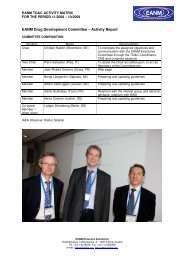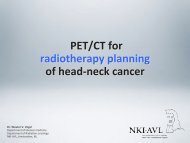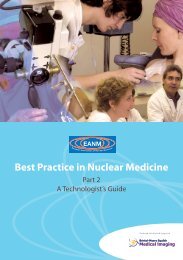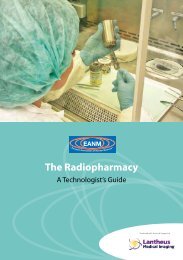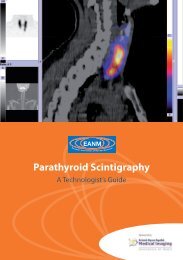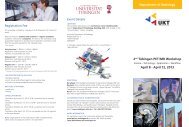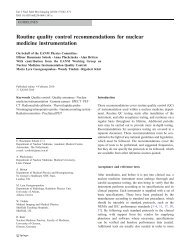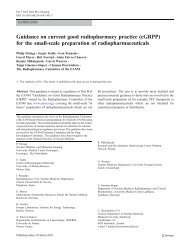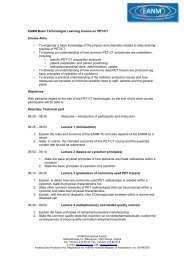Parathyroid Scintigraphy - European Association of Nuclear Medicine
Parathyroid Scintigraphy - European Association of Nuclear Medicine
Parathyroid Scintigraphy - European Association of Nuclear Medicine
Create successful ePaper yourself
Turn your PDF publications into a flip-book with our unique Google optimized e-Paper software.
•<br />
•<br />
•<br />
•<br />
windows for 99m Tc (-10% to +5% about<br />
the peak at 140 keV) and 123 I (-5% to +10%<br />
about the 159-keV peak).<br />
Acquire 2-min frames for 20 min using a<br />
zoom <strong>of</strong> 4.0 and a matrix <strong>of</strong> 128×128. A<br />
dynamic acquisition is preferable to a static<br />
one as movement correction, provided it is<br />
in the x- or y-direction, can be applied to the<br />
images. The large zoom is chosen in order<br />
to increase spatial resolution. However, this<br />
will increase noise in the image and so the<br />
acquisition must be <strong>of</strong> sufficient duration<br />
to compensate for this.<br />
Pure iodide images may be acquired for 10<br />
min. As well as being critical for processing,<br />
these pure iodide images can be beneficial<br />
in reducing false-positive cases due to thyroid<br />
disease.<br />
Without any patient movement, inject 99m Tcsestamibi<br />
followed by a 10-ml saline flush,<br />
between the 11th and 12th minute and<br />
continue the acquisition for 30 min.<br />
As a large zoom has been used, it is advisable<br />
at the end <strong>of</strong> the dynamic acquisition<br />
to carry out an unzoomed image to include<br />
the salivary glands and the heart. This will<br />
ensure the detection <strong>of</strong> any ectopic parathyroid<br />
glands, which can occur in the region<br />
<strong>of</strong> the unzoomed image. Acquire this<br />
image on the same dual-isotope settings for<br />
300 s onto a matrix <strong>of</strong> 256×256.<br />
0<br />
Processing<br />
In order to detect the increased uptake <strong>of</strong><br />
99m Tc-sestamibi in the parathyroid tissue it is<br />
necessary to subtract the 123 I image from the<br />
99m Tc-sestamibi image.<br />
The precise computer protocol will vary from<br />
centre to centre and even from camera system<br />
to camera system. However, all protocols will<br />
follow the same basic steps.<br />
Movement correction<br />
As the images have been acquired simultaneously,<br />
there will be no need to match the positions<br />
by shifting either image, but the images<br />
should be checked for movement and any<br />
correction algorithms applied before commencing.<br />
This can be as simple as checking<br />
all the frames and rejecting any with blurring<br />
before the frames are summed. This will not<br />
help if the patient has moved to a different<br />
position rather than having coughed or swallowed<br />
deeply and returned to the original<br />
position.<br />
If overall movement has occurred, the situation<br />
may be rescued if the subsequent frames<br />
can be shifted by reference to some standard<br />
point (sometimes the hottest pixel) or even<br />
by eye.<br />
The subtraction<br />
Both sets <strong>of</strong> frames (corrected if necessary)<br />
are summed to make one 99m Tc and one 123 I<br />
image.






